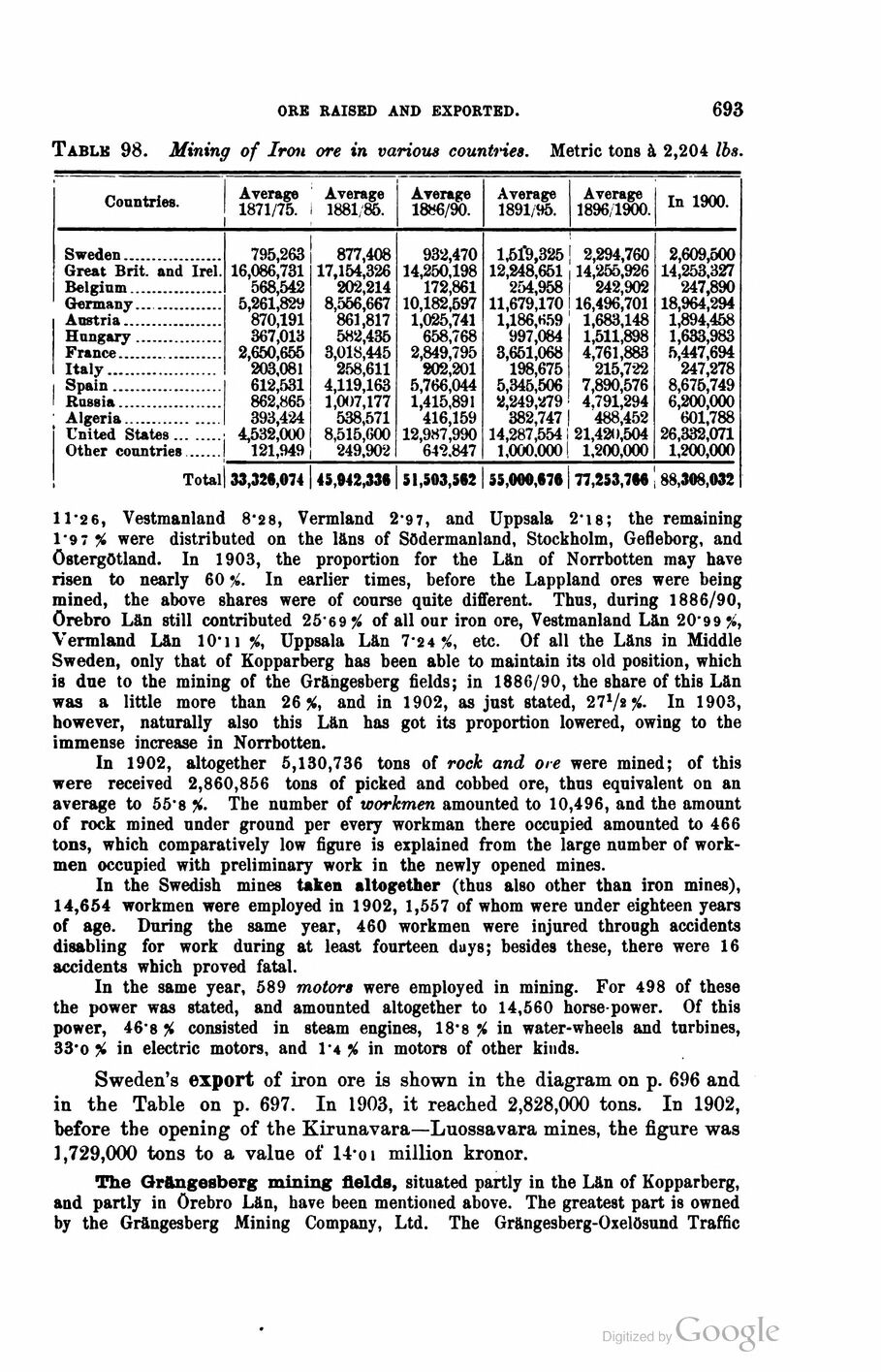
Full resolution (JPEG) - On this page / på denna sida - Second part - IX. Mining Industry and Metal Production - 1. The Iron Mines (together with information regarding other mines). By the late Prof. O. G. Nordenström - Ore raised and exported

<< prev. page << föreg. sida << >> nästa sida >> next page >>
Below is the raw OCR text
from the above scanned image.
Do you see an error? Proofread the page now!
Här nedan syns maskintolkade texten från faksimilbilden ovan.
Ser du något fel? Korrekturläs sidan nu!
This page has never been proofread. / Denna sida har aldrig korrekturlästs.
ORE RAISED AND EXPORTED. 693
Table 98. Mining of Iron ore in various countries. Metric tons à 2,204 lbs.
Countries. Average Average 1871/75. i 1881/86. Average 1886/90. Average 1891/95. Average 1896/1900. In 1900.
Sweden....................................795,263 877,408 932,470 1,5ft,325j 2,294,760 2,609,500
Great Brit, and Irel. 16,086,731 17,154,326 14,250,198 12,248,651 14,255,926 14,253,327
Belgium..................................568,542 202,214 172,861 254,958 242,902 247,890
Germany...........................5,261,829 8,556,667 10,182,597 11,679,170 16,496,701 18,964,294
Austria....................................870,191 861,817 1,025,741 1,186,659 1,683,148 1,894,458
Hungary................................367,013 582,435 658,768 997,084 1,511,898 1,633,983
France......................................2,650,655 3,018,445 2,849,795 3,651,068 4,761,883 5,447,694
Italy........................................203,081 258,611 202,201 198,675 215,722 247,278
i Spain........................................612,531 4,119,163 5,766,044 5,345,506 7,890,576 8,675,749
I Russia......................................862,865 1,007,177 1,415,891 2,249,279 4,791,294 6,200,000
Algeria..................................393,424 538,571 416,159 382,747 1 488,452 601,788
United States........■ 4,532,000 8,515,600 12,987,990 14,287,554121,420,504 26,332,071
Other countries.......I 121,949 249,902 642.847 1,000.0001 1,200,000 1,200,000
Total) 33,328,074 | 45,042,338 | 51,503,562 | 55,000,678 | 77,253,788 , 88,308,032
11*26, Vestmanland 8*28, Vermland 2-97, and Uppsala 2’i8; the remaining
1"97# were distributed on the läns of Södermanland, Stockholm, Gefleborg, and
Östergötland. In 1903, the proportion for the Län of Norrbotten may have
risen to nearly 60 %. In earlier times, before the Lappland ores were being
mined, the above shares were of course quite different. Thus, during 1886/90,
Örebro Län still contributed 25’69# of all our iron ore, Vestmanland Län 20’99
Vermland Län 10’il %, Uppsala Län 7’2 4 ’4, etc. Of all the Läns in Middle
Sweden, only that of Kopparberg has been able to maintain its old position, which
is due to the mining of the Grängesberg fields; in 1886/90, the share of this Län
was a little more than 26 %, and in 1902, as just stated, 27’/a %. In 1903,
however, naturally also this Län has got its proportion lowered, owing to the
immense increase in Norrbotten.
In 1902, altogether 5,130,736 tons of röck and ore were mined; of this
were received 2,860,856 tons of picked and cobbed ore, thus equivalent on an
average to 55"8 %. The number of workmen amounted to 10,496, and the amount
of röck mined under ground per every workman there occupied amounted to 466
tons, which comparatively low figure is explained from the large number of
workmen occupied with preliminary work in the newly opened mines.
In the Swedish mines taken altogether (thus also other than iron mines),
14,654 workmen were employed in 1902, 1,557 of whom were under eighteen years
of age. During the same year, 460 workmen were injured through accidents
disabling for work during at least fourteen duys; besides these, there were 16
accidents which proved fatal.
In the same year, 589 motors were employed in mining. For 498 of these
the power was stated, and amounted altogether to 14,560 horse-power. Of this
power, 46 8 % consisted in steam engines, 18-8 % in water-wheels and turbines,
33-o % in electric motors, and l-4 % in motors of other kinds.
Sweden’s export of iron ore is shown in the diagram on p. 696 and
in the Table on p. 697. In 1903, it reached 2,828,000 tons. In 1902,
before the opening of the Kirunavara—Luossavara mines, the figure was
1,729,000 tons to a value of 14-oi million kronor.
The Orangesberg mining fields, situated partly in the Län of Kopparberg,
and partly in Örebro Län, have been mentioned above. The greatest part is owned
by the Grängesberg Mining Company, Ltd. The Grängesberg-Oxelösund Traffic
<< prev. page << föreg. sida << >> nästa sida >> next page >>